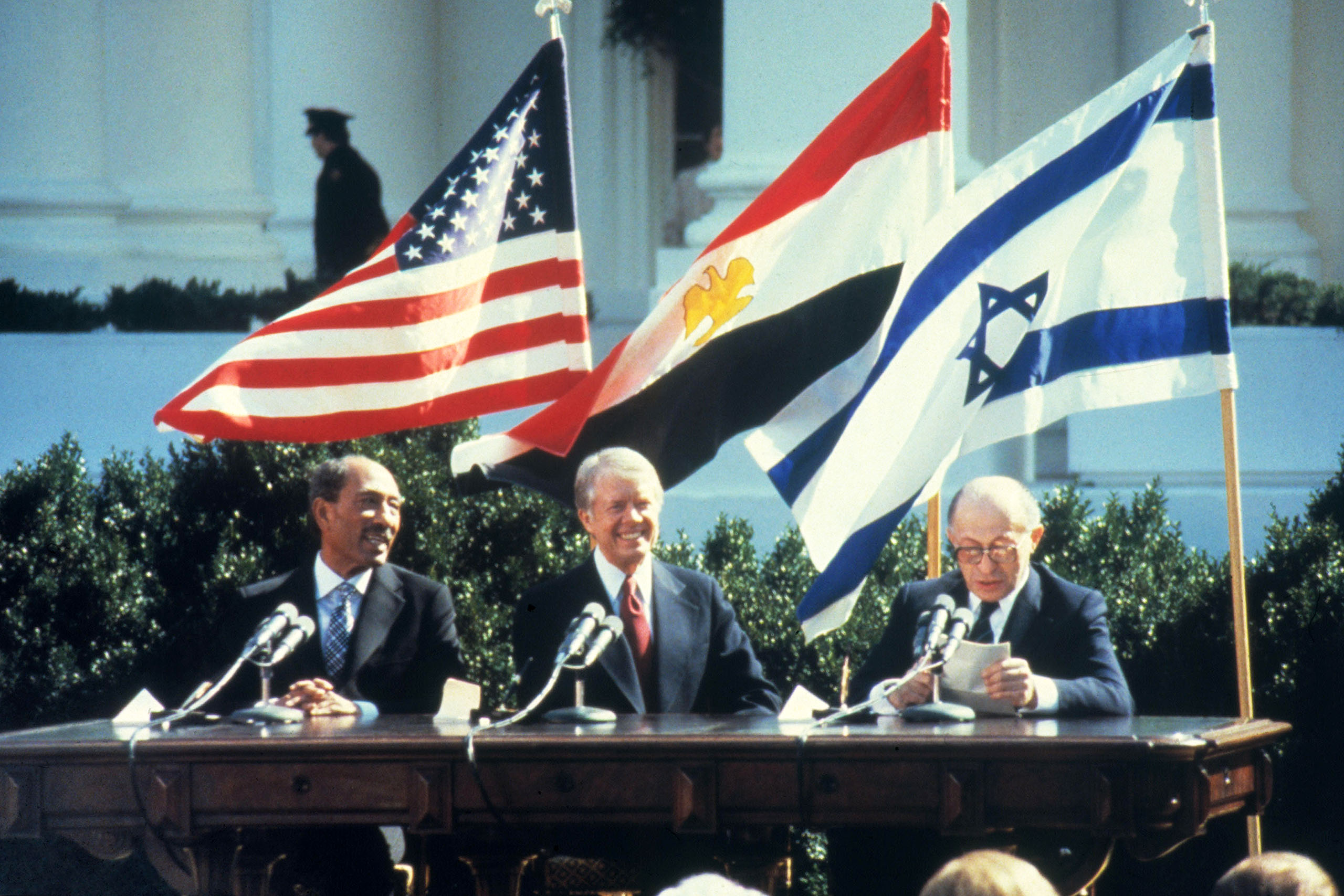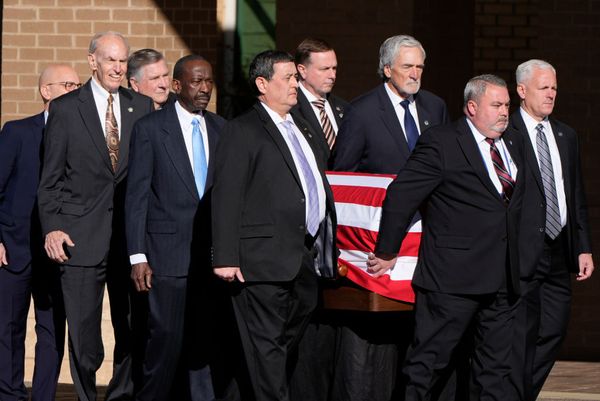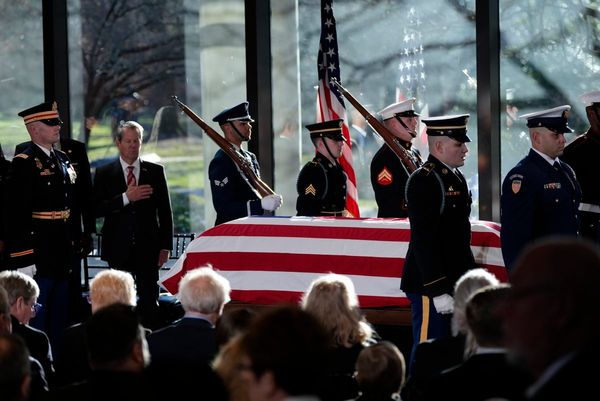
Forty-five years ago an American president took a great gamble. He invited the prime minister of Israel and the president of Egypt to the United States to negotiate a Middle East peace agreement.
Ambitious? Yes. Cyrus Vance, president Jimmy Carter’s secretary of state, called it “a daring stroke.” Foolhardy? Many thought so, including members of Carter’s staff.
Failure was a real possibility and would reflect badly on Carter, already struggling with a perception that he lacked authority. Egypt and Israel were sworn enemies who had been fighting wars since the creation of the state of Israel in 1948.
Carter took Menachem Begin and Anwar Sadat to Camp David, the presidential retreat in the Maryland mountains outside Washington, and kept them there for the next thirteen days. A media blackout prevailed until an agreement was reached. Kai Bird, author of The Outlier, a 2021 biography of Carter, described his approach as “sheer relentlessness.”
Sadat and Carter wore down an intransigent Begin until he succumbed, agreeing to a peace treaty with Egypt, including relinquishing control of the Sinai Peninsula, taken from Egypt in the 1967 war, and the dismantling of Israeli settlements there.
The agreement also included the election of a self-governing Palestinian authority in the West Bank within five years, together with (according to Carter’s detailed record) a five-year freeze on Israeli settlements there. Within three months, Israel started on a major expansion of West Bank settlements, with Begin denying the freeze had been part of the official agreement and Carter telling his staff that Begin had lied to him.
The peace treaty with Egypt, the strongest Arab state, stuck, although it cost Sadat his life. He was assassinated in 1981 by members of the Egyptian Islamic Jihad, who condemned him as a traitor for the Camp David accords.
Carter’s hopes for a broader Middle East peace have proved elusive ever since, although he could clearly see the consequences. Near the end of his presidency he wrote in his diary, “I don’t see how they” — the Israeli government — “can continue as an occupying power depriving the Palestinians of basic human rights and I don’t see how they can absorb three million more Arabs in Israel without letting the Jews become a minority in their own country.”
Nevertheless the accords were a notable achievement and unimaginable in the context of the Middle East politics of recent decades. Carter reaped a political dividend but also paid a cost: relations with the enormously powerful pro-Israel lobby in the United States were never the same again. They had not expected an American president to act as an honest broker.
Carter’s single term in the White House is generally rated among the less impressive in the presidential rankings. Yet his presidency has undergone a re-evaluation given his significant achievements in foreign and domestic policy, which look all the more substantial from today’s perspective.
In the tradition of the best political biographies, Bird gained access to volumes of material, including the copious personal diaries Carter kept as president as well as those of important figures in his administration. To learn that senior members were eating sandwiches at an important meeting in the cabinet room may not be vital to our understanding but it does point to a notable attention to detail.
Reading the narrative from the inside confirmed much of what I observed from the outside as a foreign correspondent in Washington during most of the Carter presidency. But it did so in much starker relief.
For example, the tensions between secretary of state Vance, the diplomat, and national security adviser Zbigniew Brzeziński, a cold war warrior, were evident at the time, but not their depth. Bird provides instances of what he called Brzeziński’s “highly manipulative” approach; Vance called him “evil, a liar, dangerous.”
Carter, a peanut farmer from small-town Georgia with a distinctive southern drawl, was an improbable candidate for the White House. He was a practising Baptist for whom, unlike many politicians, his religion was more than a veneer.
In a south where the echoes of the civil war still resonated and segregation continued in practice if not in name, he took a stand against racism. Yet he also was a skilled politician, elected as governor of Georgia despite his reputation as not being a typical white southerner and pragmatic when he thought he needed to be, including by downplaying his anti-racist credentials.
Still, running for president was a huge leap. He wasn’t taken seriously until he won the New Hampshire primary, and even then he was viewed with scepticism by leading members of the east-coast Democratic establishment. “He can’t be president,” said former New York governor Averell Harriman. “I don’t even know him!”
Sceptics dismissed him as self-righteous. His promise to voters that “I’ll never lie to you” prompted his friend and adviser Charles Kirbo to comment, perhaps not completely in jest, “You’re going to lose the liar vote.” But he came across to voters as sincere and authentic. And then, as now, coming from outside Washington was an advantage.
Circumstances played a large part: his Republican opponent was Gerald Ford, the sometimes hapless vice-president who had served the balance of president Richard Nixon’s term following Nixon’s resignation over Watergate. Even then, Carter won only narrowly.
In elite Washington, Carter’s team of knockabout southerners were often dismissed as hicks. But, like Carter, they were not easily deterred.
Carter brought a luminous intelligence, idealism and diligence to the White House that stands in stark contrast to the era of Trump. He argued that the world was not so easily categorised in traditional American black-and-white terms — that there was more to foreign policy than a contest between the United States and the Soviet Union. He preached against the “inordinate fear of communism” that had led to Washington’s embracing of some of the world’s nastiest right-wing dictators. The Vietnam war, he said of this approach, was “the best example of its intellectual and moral poverty.”
Bird writes that Carter rejected “any reflexive notions of American exceptionalism. He preached that there were limits to American power and limits to what we could inflict on the environment.” America didn’t go to war during Carter’s presidency — an exception up to that time and since.
He elevated human rights in foreign policy. It earned him derision from hardheads but it enhanced America’s reputation abroad, its so-called soft power.
Like any politician, though not as often, he compromised and backtracked when he judged that politics required it. Against his better instincts, he approved development of the MX missile, an expensive boondoggle championed by defence hawks, writing in his diary that he was sickened by “the gross waste of money going into nuclear weapons.”
In the wake of the OPEC oil embargo, when he was trying to persuade Congress to pass legislation to restrict energy consumption and provide funding for alternatives such as wind and solar, he diarised that “the influence of the oil and gas industry is unbelievable.” To set an example, he put solar panels on the White House roof and predicted that within two decades 20 per cent of the nation’s energy would be generated by solar power. He hadn’t count on his successor, Ronald Reagan, who removed the solar panels as one of his first acts as president, nor the ideological climate wars that followed.
While those actions were triggered by the energy crisis, he was receptive to the emerging issue of climate change. Just before leaving office, he released a report from his environmental think tank predicting “widespread and pervasive changes in global climatic, economic, social and agricultural patterns” if the world continued to rely on fossil fuels. It was a prescient warning almost half a century ago.
Carter’s domestic reforms included deregulation of sectors of the American economy, including banks and airlines, thereby increasing competition and reducing prices, though also bringing negative consequences. Consumer regulations led to mandatory seatbelts and airbags and fuel efficiency standards — something Australia is finally getting around to introducing almost half a century later. Environmental laws were passed to reduce air and water pollution; highly contested legislation locked up a large part of Alaska as wilderness and national parks, preventing oil and gas exploration.
In foreign policy, the Panama Canal treaties relinquished American control of the canal, returning sovereignty to Panama. Carter completed the normalisation of relations with China started under Nixon and negotiated an arms control agreement with the Soviet Union.
Other reforms proved to be harder sledding. Legislation on health reform that Carter thought could pass Congress was judged inadequate by Democratic liberals such as senator Edward Kennedy, who championed comprehensive national health insurance and used it as a platform to unsuccessfully challenge Carter for the Democratic nomination in 1980. It would take another thirty years for Barack Obama’s administration to enact significant, if still not comprehensive, healthcare reform.
Carter was never completely accepted by the traditional Democrats that people like Kennedy represented. It came down to suspicion about his Southern roots. Too conservative for northern Democrats, he was too much of a liberal for many southern Democrats and Republicans.
By 1979, with Americans waiting in long queues to buy petrol and paying what were then exorbitant prices for the privilege (US$1 a gallon), Carter’s presidency was at risk of sliding into oblivion. Against the almost unanimous advice of his staff, he decided on another Camp David retreat, this time a domestic summit, inviting some of the nation’s leading citizens to come up with ideas for the nation’s future. What was unusual then seems extraordinary now.
Over ten days a parade of “wise men” travelled to Camp David to diagnose the nation’s ailments and remedies. As with the Begin–Sadat summit, the rest of the nation was kept in the dark by a media blackout.
Carter emerged to give an address to the nation like none other. Sounding more preacher than president, he said America faced a fundamental crisis of confidence that no amount of legislation could fix. Americans were losing their faith in the future, worshiping “self-indulgence and consumption.”
Taking the side of the people while lecturing them at the same time, he said he no more liked the behaviour of a paralysed Congress pulled in every direction by special interests. The immediate test was beating the energy crisis, on which he announced a series of initiatives taking in a windfall profits tax on the oil industry to finance the development of domestic sources of energy, including coal and a national solar energy “bank.” (His focus was on cutting dependence on imported oil, rather than climate change.) He announced plans for rebuilding mass transit systems and a national program for Americans to conserve energy.
Contrary to the fears of his hard-headed advisors, the speech was a great success, reflected in surges in Carter’s approval ratings of 11 per cent in one poll and 17 per cent in another. He was able to convey that most precious of political commodities — sincerity.
But these and other achievements were overwhelmed late in his term by the Iranian hostage crisis. Its origins lay in the Islamic revolution and the toppling of the Shah, who the CIA effectively had re-instated as ruler of Iran in 1953 following the previous Iranian government’s nationalisation of the oil industry. Concerned by the risk to Americans in Iran, Carter resisted efforts to allow the Shah to seek refuge in the United States; but he eventually succumbed to pressure from David Rockefeller, Henry Kissinger and other establishment figures to allow him in on the pretext of urgent medical treatment.
Two weeks later, Carter’s worst fears were realised when Iranian students stormed the US embassy in Tehran and took sixty-six hostages. When diplomacy failed, Carter authorised a complex and risky rescue mission involving ninety-five commandos, a C-130 transport plane and six helicopters. A series of mechanical failures and accidents, including a collision between one of the helicopters and the C-130, resulted in the mission being abandoned.
The hostage crisis plagued the remainder of Carter’s term, reinforcing perceptions of him as a weak president. It subsequently became clear that the campaign team for Republican nominee Ronald Reagan worked behind the scenes with Iranian representatives to delay the release of the hostages, promising a better deal if he won the election. Yasser Arafat, leader of the Palestinian Liberation Organisation, had negotiated freedom for thirteen of the hostages the previous year and told Carter years later that he had rejected approaches from Reagan officials offering an arms deal if he could delay the release of those remaining.
The hostages were released on the day after Reagan’s inauguration following his landslide win in the 1980 election. Soon after taking office, the new administration, despite publicly maintaining Carter’s embargo on arms sales to Iran, secretly authorised Israel to sell military equipment to Iran.
The hostage crisis was not the only reason for the relatively rare election loss by a first-term president. Carter’s support was sapped by the 1970s ailment of stagflation — high inflation and stagnant economic growth — together with the energy crisis. Reagan, the former Hollywood actor, had an appealing personality and a now-familiar slogan: “Make America great again.”
James Fallows, speechwriter for the first two years of the administration, says that Carter invented the role of former president. He certainly had an active four decades of public life following the presidency, with the 110-strong staff of the Carter Centre in Atlanta working on human rights, preventive health care, election monitoring and international conflict resolution.
Carter raised millions of dollars for a program that virtually eradicated guinea worm, a parasitic disease that had disabled and disfigured 3.5 million people a year in Africa and India. His centre helped distribute twenty-nine million tablets in Africa and Latin America for the treatment of river blindness, another disease caused by a parasitic worm. “Americans got used to seeing this ex-president, dressed in blue jeans with a carpenter’s belt, hammering nails into two-by-fours for a house under construction by a team of volunteers for Habitat for Humanity,” Bird writes.
In the 1980s, he spoke out about the concerns he had developed about the Middle East when he was president but he had judged were too dangerous to express publicly. “Israel is the problem towards peace,” he said, citing particularly the expansion of settlements on the West Bank. Accused of bias, he responded that “a lot of the accusations about bias are deliberately designed to prevent further criticism of Israel’s policies. And I don’t choose to be intimidated.” In 2006, he published his twenty-first book with the provocative title, particularly then, of Palestine: Peace Not Apartheid, earning him epithets such as “liar,” “bigot” and “anti-Semite.”
By then Carter had been awarded the 2002 Nobel Peace Prize for “decades of untiring effort to find peaceful solutions to international conflicts, to advance democracy and human rights and to promote economic and social development.”
After he was diagnosed with cancer in 2015 he said, “I’d like for the last guinea worm to die before I do.” Nine years later, aged ninety-nine and in palliative care, he is still going, if not strongly — a metaphor for a lifetime of indefatigability. •
The post Prescient president appeared first on Inside Story.







